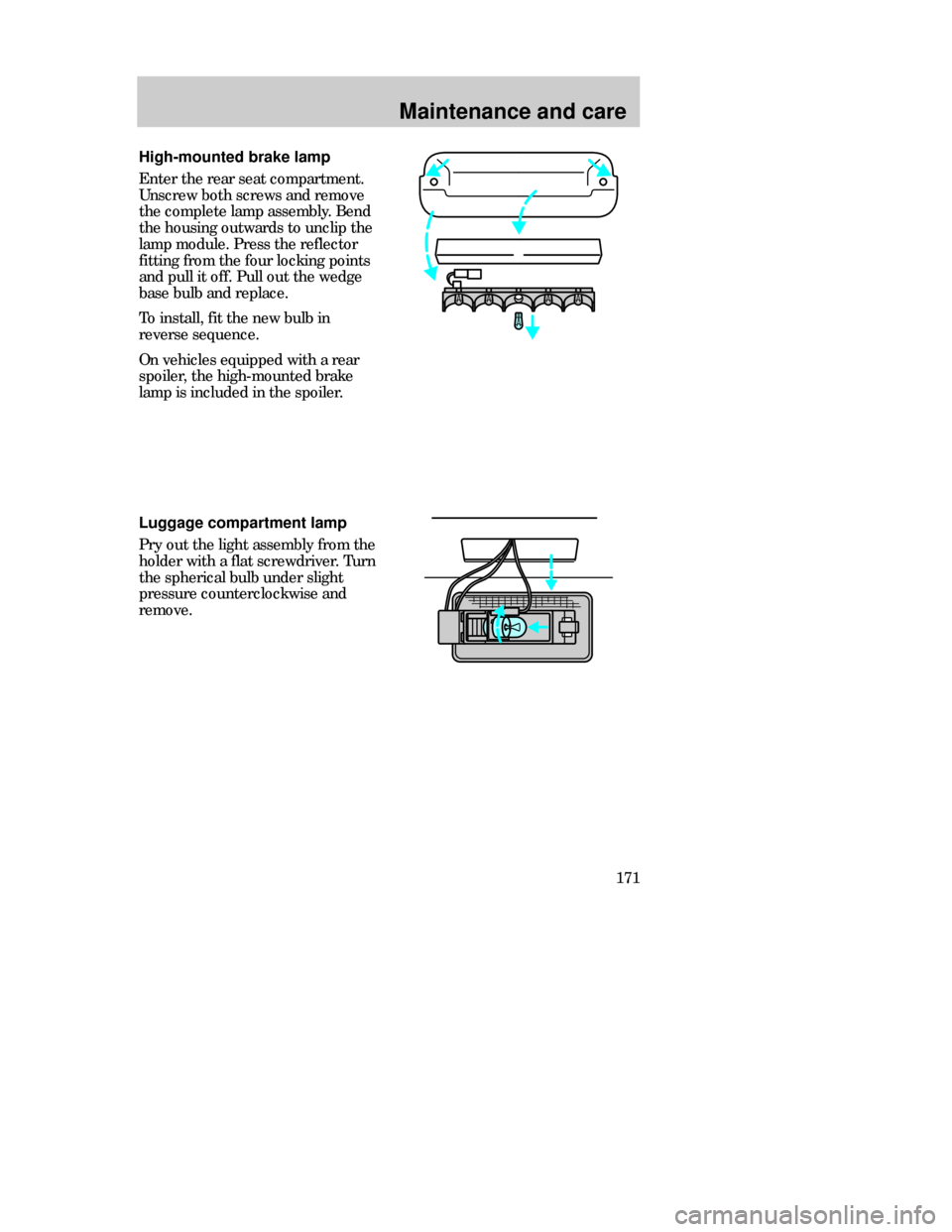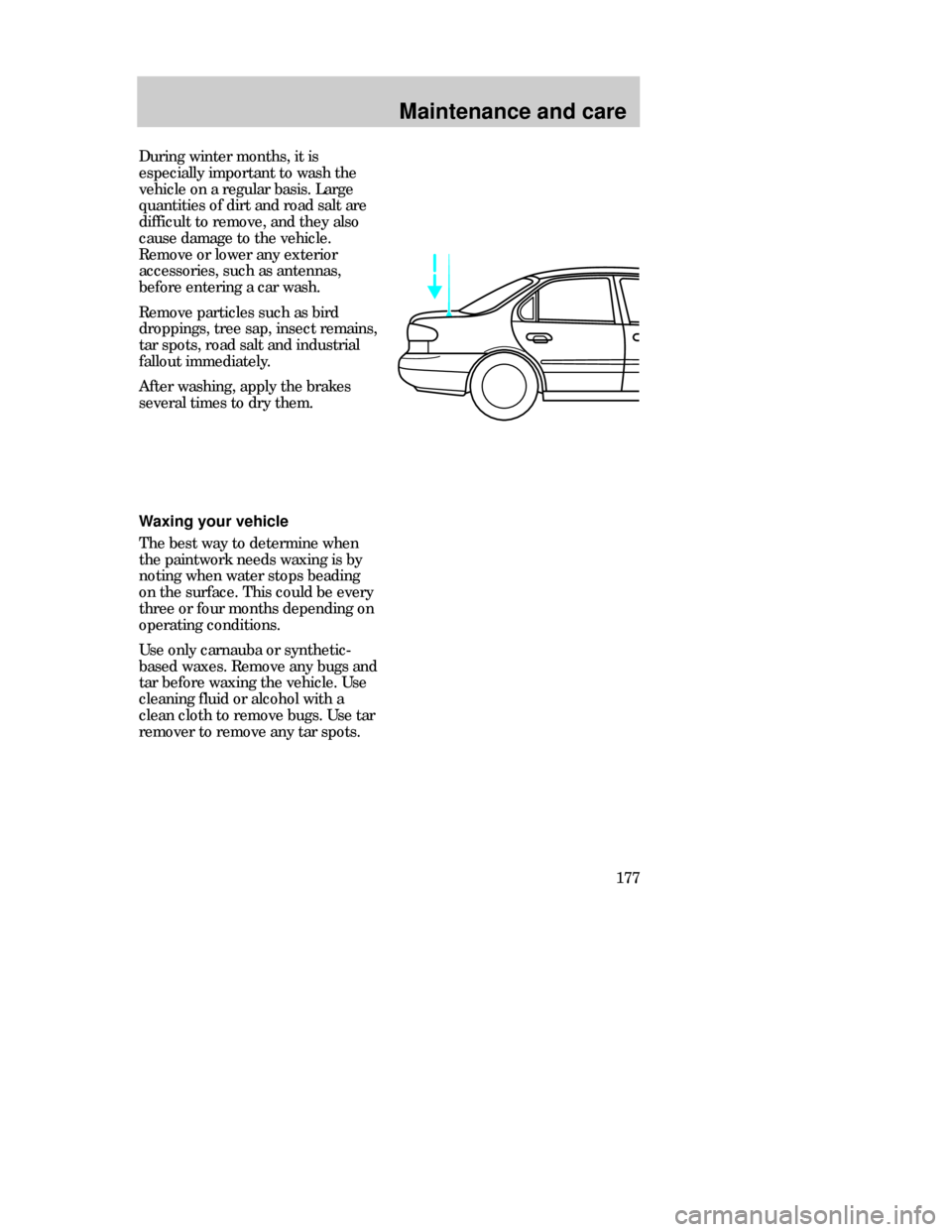Mercury Mystique 1998 Owner's Manuals
Mystique 1998
Mercury
Mercury
https://www.carmanualsonline.info/img/33/11005/w960_11005-0.png
Mercury Mystique 1998 Owner's Manuals
Trending: maintenance reset, suspension, oil dipstick, maintenance schedule, driver seat adjustment, wiper fluid, wiper blades
Page 171 of 196
Maintenance and care
171
High-mounted brake lamp
Enter the rear seat compartment.
Unscrew both screws and remove
the complete lamp assembly. Bend
the housing outwards to unclip the
lamp module. Press the reflector
fitting from the four locking points
and pull it off. Pull out the wedge
base bulb and replace.
To install, fit the new bulb in
reverse sequence.
On vehicles equipped with a rear
spoiler, the high-mounted brake
lamp is included in the spoiler.
Luggage compartment lamp
Pry out the light assembly from the
holder with a flat screwdriver. Turn
the spherical bulb under slight
pressure counterclockwise and
remove.
CDW VA1-19Maint en MM 5/15/97 7:56 PM Page 171
Page 172 of 196
Maintenance and care
172
FunctionTrade number
3457 NA
9005
9006
893
1157
1156 Front /turn lamp
Headlamp (high)
Headlamp (low)
Fog lamp
Rear tail/turn/brake lamp
Backup lamp
Bulb specifications
2723
C5W
High-mounted brake lamp
License plate lamp
Reading lamps (if equipped)
Open the lamp assembly.
The bulbs can be replaced after the
contact plate has been hinged
back. Interior lamps
Switch off the interior lamps
(middle switch position). Pry out
the lamp assembly with a flat
screwdriver, release the reflector at
the side and replace the festoon
bulb.
To install, fit the new bulb in
reverse sequence.
CDW VA1-19Maint en MM 5/15/97 7:56 PM Page 172
Page 173 of 196

Maintenance and care
173 Aiming the headlamps
Your vehicle is equipped with a
Vehicle Headlamp Aim Device
(VHAD) on each headlamp body.
Each headlamp may be properly
aimed in the horizontal direction
(left/right) and the vertical position
(up/down).
A non-zero bubble reading does not
necessarily indicate out-of-aim
headlamps. If your vehicle is not
positioned on a level surface, the
slope will be included in the level
indicator. Therefore, vertical
headlamp adjustment should be
performed only when beam
direction appears to be incorrect
and a level surface can be verified. AIMING THE HEADLAMPS
The alignment of your headlamps
should be checked if:
•Oncoming motorists frequently
signal you to deactivate your high
beams, and your high beams are
not activated.
•The headlamps do not seem to
provide enough light for clear
night vision.
•The headlamp beams are pointed
substantially away from a slightly
down and to the right position.
CDW VA1-19Maint en MM 5/15/97 7:56 PM Page 173
Page 174 of 196
Maintenance and care
174
Adjusting the horizontal aim
1. Make sure the vehicle is on a
level surface.
2.With the hood open, locate the
horizontal indicator and adjusting
screw.
3. Turn the horizontal adjusting
screw until the reference mark on
the reflector extension aligns with
the “0” reference mark on the
horizontal indicator when viewed
directly from above.
4. When the horizontal aim has
been adjusted, close the headlamp
access panel. The horizontal aim must be
adjusted first. You will need one 7
mm box wrench, open end wrench
or T-15 Torx drive.
The following procedures assumes
that the vehicle’s front structure is
properly aligned. If the vehicle has
been in an accident requiring the
front end of the vehicle to be
repaired, the horizontal indicator
should be recalibrated by your
dealer or a qualified service
technician.
CDW VA1-19Maint en MM 5/15/97 7:56 PM Page 174
Page 175 of 196
Maintenance and care
175
Adjusting the vertical aim
The numbers shown on the vial
indicate beam direction in degrees
up or down.
1. Do not adjust the vertical aim
until after adjusting the horizontal
aim.
2. With the hood open, locate the
bubble level vertical aim indicator.
It is visible when viewed from the
above rear of the headlamp.
3. Turn the vertical adjusting screw
until the reference mark on the
reflector extension aligns with the
“0” reference mark on the vertical
indicator when viewed from
directly above.
4. Close the hood.
CDW VA1-19Maint en MM 5/15/97 7:56 PM Page 175
Page 176 of 196
Maintenance and care
176
Washing your vehicle
Only use car washing areas
that have environmentally
friendly drainage systems.
VEHICLE CARE
Wash your vehicle regularly with
cold or lukewarm water. Never use
strong detergents or soap. If your
vehicle is particularly dirty, use a
quality car wash detergent. Always
use a clean sponge, washing glove
or similar device and plenty of
water for best results. To avoid
spots, avoid washing when the
hood is still warm, immediately
after or during exposure to strong
sunlight.
CDW VA1-19Maint en MM 5/15/97 7:56 PM Page 176
Page 177 of 196
Maintenance and care
177 Waxing your vehicle
The best way to determine when
the paintwork needs waxing is by
noting when water stops beading
on the surface. This could be every
three or four months depending on
operating conditions.
Use only carnauba or synthetic-
based waxes. Remove any bugs and
tar before waxing the vehicle. Use
cleaning fluid or alcohol with a
clean cloth to remove bugs. Use tar
remover to remove any tar spots.
During winter months, it is
especially important to wash the
vehicle on a regular basis. Large
quantities of dirt and road salt are
difficult to remove, and they also
cause damage to the vehicle.
Remove or lower any exterior
accessories, such as antennas,
before entering a car wash.
Remove particles such as bird
droppings, tree sap, insect remains,
tar spots, road salt and industrial
fallout immediately.
After washing, apply the brakes
several times to dry them.
CDW VA1-19Maint en MM 5/15/97 7:56 PM Page 177
Page 178 of 196
Maintenance and care
178Repairing paint chips
Minor scratches or paint damage
from road debris may be repaired
with touch-up paint, paint repair
foil or aerosol spray from the Ford
accessories line. Observe the
application instructions on the
products.
Cleaning the wheels
Wash the wheels with the same
detergent you use to clean the
body of your vehicle. Do not use
acid-based wheel cleaners, steel
wool, fuel or strong detergents.
Never use abrasives that will
damage the finish of special wheel
surfaces. Use a tar remover to
remove grease and tar.
CDW VA1-19Maint en MM 5/15/97 7:56 PM Page 178
Page 179 of 196
Maintenance and care
179 Cleaning the engine
Engines are more efficient when
they are clean because grease and
dirt buildup act as insulators and
keep the engine warmer than
normal. Follow these guidelines to
clean your engine:
•Take care when using a power
washer to clean the engine. The
high pressure fluid could
penetrate the sealed parts and
cause damage.
•Do not spray with cold water, to
avoid cracking the engine block.
•Cover the alternator to prevent
water damage when cleaning the
engine.
•Never wash or rinse the engine
while it is running; water in the
running engine may cause
internal damage.
CDW VA1-19Maint en MM 5/15/97 7:56 PM Page 179
Page 180 of 196
Maintenance and care
180Cleaning plastic exterior parts
Use a vinyl cleaner for routine
cleaning of plastic. Clean with a tar
remover if necessary. Do not clean
plastic parts with thinners, solvents
or petroleum-based cleaners.
Cleaning the exterior lamps
Wash the exterior lamps with the
same detergent you use to wash
the exterior of your vehicle. Use
glass cleaner or tar remover if
necessary.
To avoid scratching the lamps, do
not use a dry paper towel, chemical
solvents or abrasive cleaners to
clean the lamps.
Cleaning the wiper blades
If the wiper blades do not wipe
properly, clean both the windshield
and wiper blades using undiluted
windshield wiper solution or a mild
detergent. Rinse thoroughly with
clean water. To avoid damaging the
blades, do not use fuel, kerosene,
paint thinner or other solvents.
CDW VA1-19Maint en MM 5/15/97 7:56 PM Page 180
Trending: mileage, recommended oil, jump cable, coolant temperature, low oil pressure, service reset, coolant capacity



















